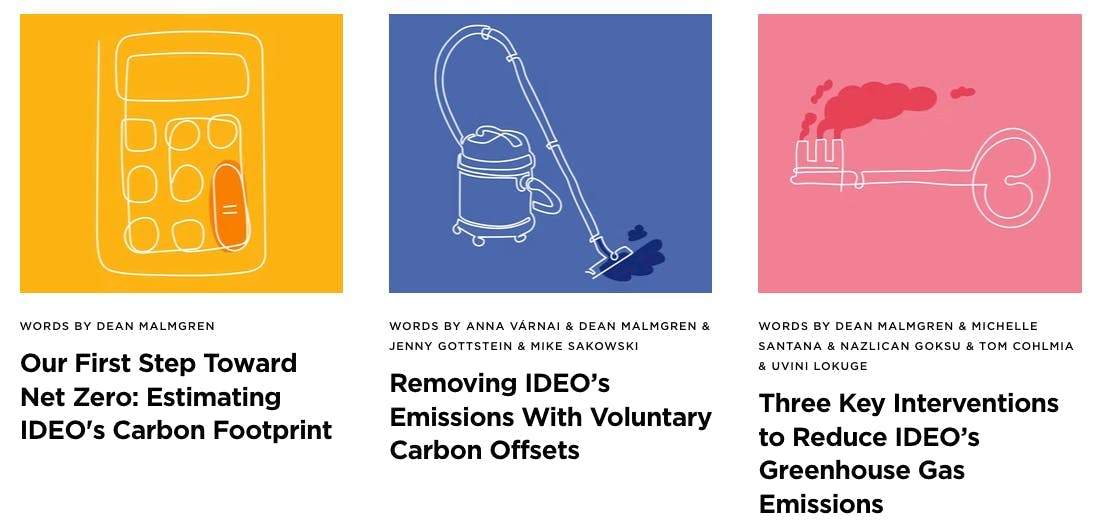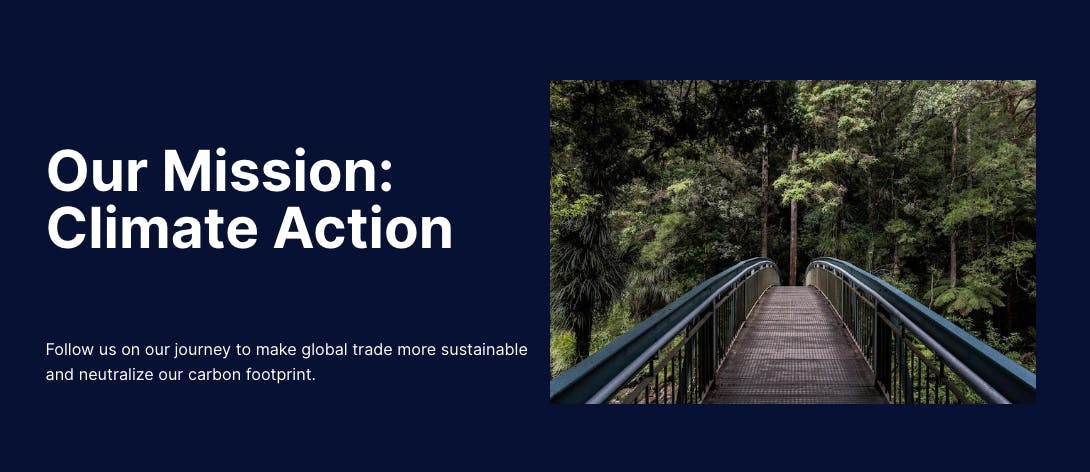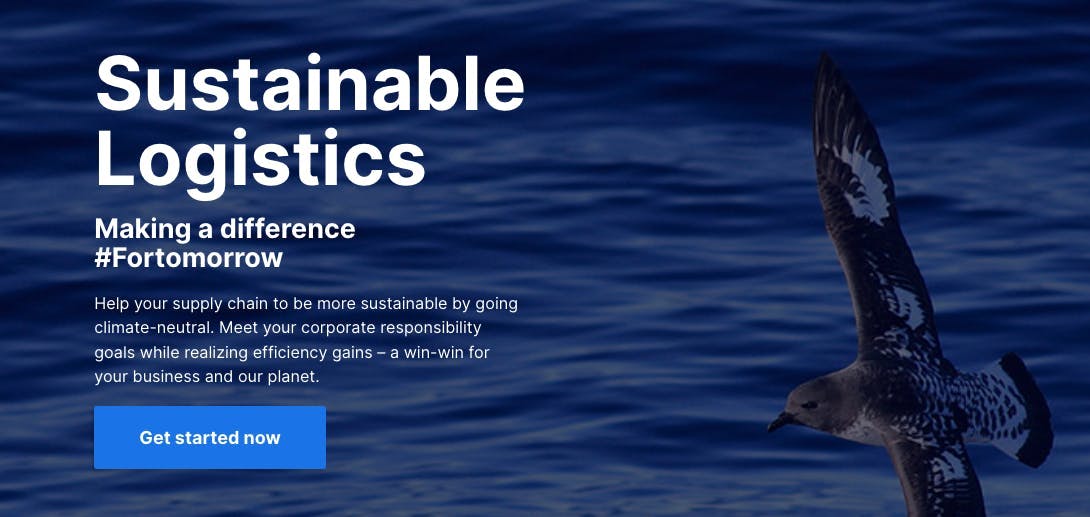

Business sustainability initiatives have a communication problem.
Typically, companies publish a sustainability report which details all their plans, targets, and work so far. These reports take a significant amount of time and effort to produce – but often go unnoticed by customers.
It’s a wasted opportunity.
Consumers, investors, employees – they’re all actively looking for purpose-led and climate-friendly brands, and they’re way more likely to stay loyal to them when they come across them. But if they don’t know about your climate initiatives, they’re going to move on to another option.
On the other hand some companies take it to the other extreme, seeing their climate initiatives as a huge marketing and PR opportunity. This is all very well, but often this approach leads to hugely exaggerated eco credentials – greenwashing, in other words. And that could damage your brand in a big way.
So as you can see, getting sustainability communications right can be tricky.
How do you overcome these hurdles and successfully communicate business sustainability? Start by adhering to these 7 principles:
- Be honest and transparent
- Check your facts
- Avoid jargon
- Make it relevant
- Make it visible
- Make sure it isn’t a one-off communication
- Ask for help if you aren't sure
1. Be honest and transparent
It’s crucial to tell the true, honest story of your climate journey to gain trust.
We’re all on a collective journey when it comes to responding to the climate emergency, and your customers are well aware of that. Making exaggerated or unsubstantiated claims is a sure-fire way to lose your audience’s trust and make them assume you’re simply greenwashing.
So, the #1 rule is to be open and transparent.
The research on trustworthy, evidence-based sustainability communication backs this up too, highlighting two key components as honesty and having good intentions.
Share the story of your journey so far, including:
- Start with why – what are your motivations for exploring climate impact?
- Why you decided to approach sustainability in the way you have
- Your goals and targets for sustainability – and how this fits into your wider business strategy (because climate should never be seen as a separate or standalone initiative)
- What actions you’ve taken so far towards this vision
- Any limitations or struggles you’ve encountered so far – and what you’re doing about them
- What further actions you’ll be taking in the future.
Sharing your journey in this way hits all three of those components to gain trust – showing that you’ve done your research and put a lot of thought into how you’re approaching sustainability and have started making improvements towards that, whilst acknowledging that there’s more you could do to continue learning and improving.
Take design company IDEO for example.
They published a series of blogs on their website sharing their sustainability work. The first blog ‘You’ve just got to get started’ is an honest account of the start of their journey, highlighting that it is just that – a journey:
This is the kind of honest and transparent storytelling that gains trust – you can tell that IDEO are working on climate for the right reasons.

The blog series continues with more tangible information on their process and progress so far, including how they measured their own carbon footprint and how they’re working with Lune as a sustainability partner to offset their emissions in alignment with the Oxford Offsetting Principles.

2. Check your facts
The third key component highlighted in the research on evidence-based sustainability communication is expertise.
That means you need to be confident in the approach you’re taking. Sharing your motivations and the reasoning behind how you’re approaching climate impact (as highlighted in #1) is a big first step to this.
Beyond that, make sure you:
- Check any facts, statistics, or claims you make
- Reference evidence or sources you’ve used
- Include any partners you’re working with to add weight to your approach e.g. we’re working with Lune as our trusted partner for carbon offsetting.
3. Avoid jargon
The business world loves buzzwords. So is the world of climate change.
Combining the two means there’s a lot of potential for communications full of jargon and buzzwords. Which could leave customers and stakeholders confused about what you’re actually talking about.
Plus, you need to be careful about the climate-related terms you use. Many of them are misused when nuances aren’t fully understood.
Terms like climate neutral, net zero, carbon negative etc have very specific meanings and implications – but you’ll often see businesses claiming to be ‘carbon neutral’ without providing evidence that aligns with the accepted definition of that term.
We’d suggest keeping the language you use in your sustainability communications super simple, so there’s no chance of misinterpretation.
Subscribe for the latest insights into driving climate positivity
4. Make it relevant
Know your audience.
It’s a central principle of any marketing messaging – and that includes business sustainability communications.
Why do your audience care about your climate efforts? What’s in it for them?
If you’re a B2C company e.g. in the retail industry, maybe it means that your customers have the peace of mind of knowing that you’re ensuring their purchase won’t negatively impact the environment.
If you’re B2B, maybe it means that you’re making it easy for your customers to address their own climate impact and give their own customers climate-friendly options – a payments company offering a green payment option for merchants to include in their checkout process or a logistics company enabling merchants to automatically offset the emissions from product deliveries, for instance.
It might even be that you’ve been receiving direct feedback from your customers that they’d like a greener option. If so, reference that too.
5. Make it visible
Once you’ve cracked your messaging and the story of your climate journey, you need to make it visible.
Remember what we said about climate work in a silo? It’s a missed opportunity for increased impact, potential partnerships, and brand boosting.
Some suggestions:
- Launch your climate communications internally first – your employees can be incredible advocates and amplifiers if they share with their networks, plus they need to understand how sustainability fits into their own role too. We’d always suggest a company-wide workshop or briefing before you go public with your climate plans, allowing for questions and feedback too.
- Look for ways to integrate climate communication within the customer journey itself e.g. adding messaging at checkout about the emissions of a purchase and what you’re doing to address that as a company.
- Ensure your climate work is easy to find on your website – you could consider adding a sustainability or climate action webpage or blog where you add updates on your journey and progress towards goals.
- Consider creating visual representations or comparisons to increase understanding. We’re all still learning when it comes to climate change, and it can be hard to understand what e.g. 100 tons of CO2e really means. Comparing this to a number of air miles travelled or showing how these emissions all add up over time to create the climate impacts we’re dealing with, can help comprehension.
- Take the opportunity to create content and work in collaboration with others. For instance, you could tell your story through a series of blog posts or host webinars around different climate-related topics. If you’re working with partners on your sustainability journey, you could collaborate with them on this. Or you could work with others in your industry to explore the topic of climate impact in your sector more widely.
- Enable questions and feedback. Climate communications are best as a conversation rather than a one-sided announcement, as your customers are likely to have questions. Consider a webinar about your climate journey, or publishing a list of FAQs.
Logistics company Forto, for instance, have a dedicated climate action webpage detailing their own climate impact as a business, and what they’re doing to address it….

… and they also have a sustainable logistics webpage highlighting how they can work with their customers on their climate impact too. Their merchants are also prompted with this information when they become Forto customers, making climate impact front and centre in their minds.

6. Make sure it isn’t a one-off communication
Telling your climate journey effectively means sharing updates on the regular about your progress – it shouldn’t be a one-off communication.
That’s why the best form of communication about climate is integrating messaging within the customer journey itself, so that there’s true visibility of the climate impact of your product or service and that your customers are engaged with how to address that.
Beyond that, ensure that for whatever communications you do put out about your business sustainability you agree with your team how often you’ll check and update those communications.
7. Ask for help if you aren’t sure
Even with these principles for successfully communicating business sustainability in hand, we know that the fear of getting it wrong and greenwashing can be intimidating, especially if you don’t have internal expertise on climate.
That’s where it can be incredibly valuable to work with sustainability partners that you trust. They can work with you to shape your messaging and communications, adding expertise and ensuring you don’t accidentally say the wrong thing.
For instance, at Lune we work with all our customers to ensure they’re comfortable with going to market with their climate initiatives – including 1:1 marketing support and providing templates and frameworks as a starting point.
Readers also liked
Readers also liked

Subscribe for emissions intelligence insights
Get the latest updates in the world of carbon tracking, accounting, reporting, and offsetting direct to your inbox.


